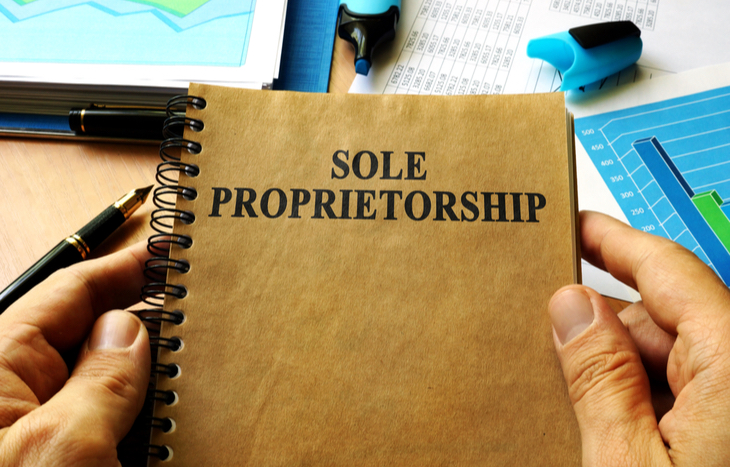What is a Sole Proprietorship?
If you’re getting into business for yourself and want to legitimize your venture, you’ll need to incorporate. Often, the answer is a sole proprietorship. The simplest and most common form of business ownership, a sole proprietorship is owned by an individual who’s responsible for all debts of the business. Unlike other business structures, it’s not a separate entity from the owner. You are your business and your business is you.
Sole proprietorships represent the bulk of all businesses in the United States. That said, you won’t find any on Wall Street—only corporations can become publicly traded entities. In fact, sole proprietorships don’t issue any shares at all, since there’s only one vested interest in the business. Nevertheless, they’re worth understanding from an investment point of view.
Here’s a quick rundown of sole proprietorships, how they work and what their structure means for those at the helm.

The Benefits of Sole Proprietorships
Many of the benefits associated with sole proprietorships revolve around the simplicity of establishing and maintaining one. To establish one, individuals simply need to start operating. There’s no tax entity to establish, which means no formal paperwork or registration required.
The cost of operating a sole proprietorship is also nominal. The individual doesn’t need to worry about paying corporate taxes, maintaining a filing or paying many of the costs associated with incorporating a business. The only real costs are those involved with maintaining the business and, of course, personal income taxes paid on the profits.
Speaking of taxes, a sole proprietorship is a pass-through tax situation. Because there is no incorporated business, it can’t pay taxes. Instead, the individual operating the business assumes responsibility for all taxes paid on profit. Filing taxes is a matter of submitting a Schedule C for business activity alongside your year-end or quarterly personal income tax filing.
Finally, there’s a high level of operational ease associated with this simplified business format. Since the individual is the business, there’s no need to separate banking accounts or assets. Individuals can conduct business intertwined with personal finances, without running into scrutiny. Although, as we’ll explore in a moment, this isn’t always a good idea.
The Drawbacks of a Sole Proprietorship
Sole proprietorships serve an important role in the earliest days of a new business venture. That said, as businesses grow, proprietorships quickly become antiquated. They’re not equipped to handle the increased potential for liability and financial complexities that accompany a growing enterprise.
The biggest downfall of a proprietorship is the lack of separation between the business and the individual. In the event of legal action against the business or insolvency, those responsibilities pass on to the person running it! This opens the door for unlimited liability. Incorporating the business adds a layer of protection that separates the business and the individual.
Another downfall for growing businesses is the inability to secure capital for an unstructured enterprise. Investors want to buy into a legitimate business: not a person. Raising capital through a sole proprietorship is almost impossible, and many banks will treat loans as personal loans instead of business loans. Unless you plan to bootstrap your way to success, incorporation is a better way to secure capital.
The Transition From Proprietorship to Corporation
As sole proprietorships grow into more mature companies, owners need to think about transitioning to a different business structure. The broader the financial operations of the business, the more personal liability the owner takes on. A shift to an LLC, S-Corp or C-Corp further legitimizes the business and adds a buffer of protection between owners and their business. Moreover, it enables the company to issue shares to partners and investors.
Making the leap from proprietorship to corporation involves filing with local and state authorities to obtain an Employer Identification Number (EIN), used to file the business’ taxes. Transitioning proprietorships also need to file articles of incorporation and other legal documentation to secure the business’ name and register it with tax authorities and other registrars.
Sole Proprietorship vs. Self-Employed
In the era of the gig economy and ease of entrepreneurship, many self-employed individuals will find themselves at the helm of their own business. Is operating a sole proprietorship the same as being self-employed? Yes. Just like a freelancer or contracted worker, individuals running a sole proprietorship need to file a Schedule C alongside their Form 1040 when doing their taxes. The Schedule C is a record of business income and losses, meant to contextualize the income reported on Form 1040.
The Simplest Way to Start a Business
A sole proprietorship is the simplest, most efficient way to start a business. In fact, it’s so simple that many entrepreneurs inadvertently start one on their way to creating something more structured, like an LLC. And while most sole proprietorships become incorporated entities, for a time they’re a straightforward way for aspiring business owners to get their idea off the ground.
And you can learn how to build wealth in your life by making informed business and investment decisions! Just sign up for the Liberty Through Wealth e-letter below for daily updates on stock market trends and other investment opportunities!
The biggest downfall of a sole proprietorship—and the reason most evolve into a corporation—is because they come with unlimited liability. Business owners are responsible for all the profits and losses from operation, and are open to liability that could affect their personal finances. Evolving into an LLC or other corporation isn’t only a sign of business maturity, it’s a sign of mitigated liability. Until it becomes big enough to warrant incorporate, most businesses get their start as a budding sole proprietorship: a motivated founder with a great idea.





